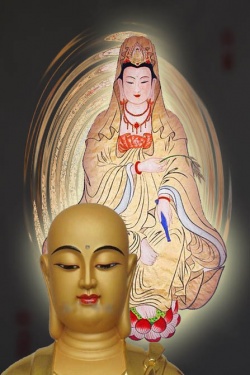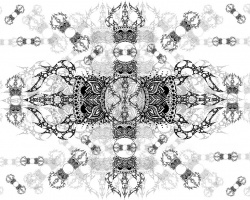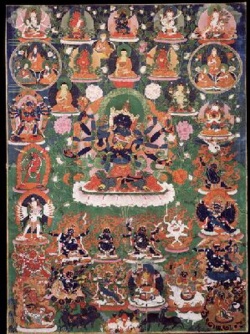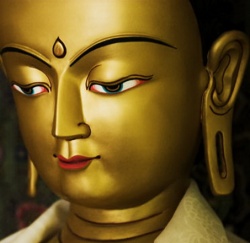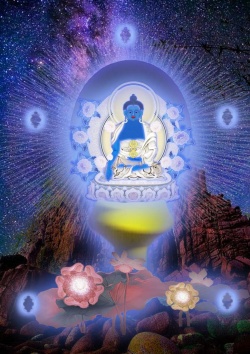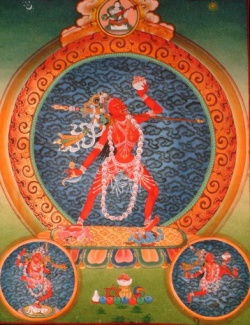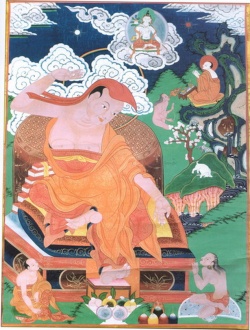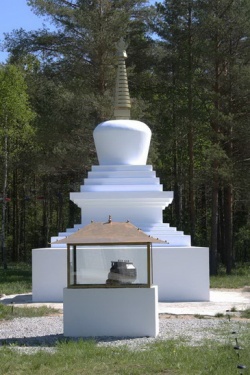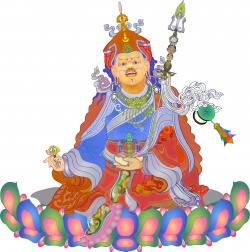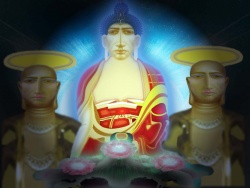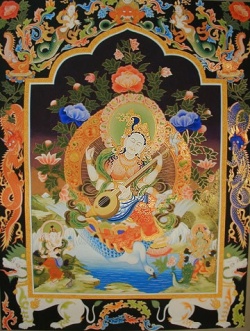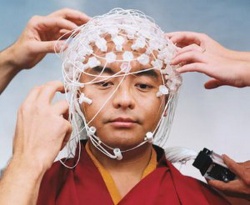Subtle matter
Subtle Matter; Rarefied or weightless matter (supposedly) pervading the atmosphere, the universe, the animal body, etc.; a substance of this nature;
especially ether or the fluid believed to be responsible for electromagnetic phenomena. Mid 17th cent.; earliest use found in Robert Boyle (1627–1691), natural philosopher.
Is mind matter, or is it separate from matter, or does it matter in our pursuit of happiness?
Such questions have troubled philosophers as well as psychologists from time immemorial. Western philosophers give credit to Rene Descartes (17th Century) for proposing that mind is not physical matter, since it has no spatial (or physical) dimensions, and it is identified with consciousness and self-awareness.
Even though it is not physical matter, it closely interacts with physical matter, particularly with the physical body.
For, it is noted that the 'mental moods' of passions such as love, hate, jealousy, fear, happiness, sorrow, etc, and sometimes even strong emotionally rooted beliefs, can have notable and significant interactions at body level. Mental depressions can affect physical health.
Psychosomatic diseases are common. Addictions and drugs can bring about mental imbalance and strong mental disturbances can generate poisonous chemicals in the body.
Thus mind and matter appear to be interconnected, since each affects the other. What exactly is the relation between the two is not known although many theories have been proposed.
There is a theory called 'Substance Dualism' that states that mind is an independently existing substance separate from the physical matter constituting the body (the brain), but its substantive is not known.
There is another theory called 'Property Dualism' which states that the substance of the mind is not different from physical matter, though its properties are different.
There is also a theory called 'Monism' that states that body and mind are ontologically the same. Thus many ‘-isms’ have been proposed, each postulating the relation between the mind and matter.
From the clinical side, it is evident that mind can be affected by certain chemicals and addiction to drugs has become a world-wide problem.
In the dualistic models, starting from that of Descartes, mind is considered as 'consciousness' or 'self-awareness' or at least 'somehow' related to consciousness. Hence mind-matter duality is ultimately reduced to consciousness-matter duality.
The current western thinking is that consciousness 'somehow' arises in matter in just the same way as the mind operates in the physical body.
Many of these concepts are really not new and are borrowed from age-old philosophies, but are presented in an acceptable form to be marketable as new theories.
From a Vedantic perspective (philosophical truths discussed in the end part of the Vedas called Upanishads), mind is considered to be subtle matter different from gross physical matter.
The subtle part of the gross food that we eat sustains the mind. Hence the food that we eat can also affect the mind.
For example, mind can be made be aggressive, passive or lethargic, etc, depending on the type of food we eat.
To enhance the contemplativeness of the mind certain foods, called sattvika, are recommended, while certain others - rajasika and tamasika - are to be avoided. Similarly, for the mind to be active or aggressive, e.g. for warriors, rajasika foods are recommended.
Thus it was recognized that gross matter does affect the subtle mind and its properties.
Consciousness and mind are considered separate by some philosophers while others consider ‘conscious mind’, where the mind is conscious of objects as in the waking state, to be equated to consciousness.
It is recognized, therefore, that there is an interrelationship between (or among) consciousness, mind and matter.
What exactly is the relation between the two or the three is not known, although there are many theories and postulates. A person can be made unconscious by chloroform or placed into different degrees of unconsciousness by addictive drugs like morphine.
Is consciousness a special property of matter that arises when certain conditions are met, or is it the other way, i.e. does matter arise in consciousness? The former is more acceptable for physical or material scientists, but the latter may be closure to the truth.
Is there really matter separate from the conscious mind? There is a philosophy called Idealism, which maintains that the mind is all that exists, and the external world is either a mental projection or an illusion created by the mind.
(This theory of Idealism, which is somewhat similar to the vijnanavada philosophy of Buddhism, is different from Advaita Vedanta, although there are some who vehemently argue that they are the same.)
For the mind to exist, there has to be a locus for its existence, which has to be the body made of matter.
This will reduce to a circular argument if, according the Theory of Idealism, matter is a projection of the mind, since mind then depends on matter while matter is a projection of the mind.
Another important question is whether consciousness of 'an object' or of 'the world' is different from self-consciousness (i.e. awareness of one's own self, where the subject itself is an object of consciousness, i.e. I am conscious of myself).
Some Vedantins (particularly vishishtadvaitins) argue that there are two types of consciousness: one is self-consciousness and the other is object-consciousness.
These are called dharmi j~nanam and dharma bhuta j~nanam, respectively.
Fundamental to this classification is that the subject, 'I', is different from the object, 'this'. The self-consciousness (dharmi j~nAnam) is always present, since it is intrinsic to oneself, while the object-consciousness manifests in a conducive environment, when there is an object present of which one wants to be conscious.
A question that arises at this juncture is whether I can be conscious of myself, that is self-awareness that I am as 'I am', without having an object of consciousness.
When I am conscious of an object 'this', I am conscious that 'I' know 'this' where the subject thought 'I' and the object thought 'this' are present simultaneously in the mind.
This subject-object duality forms an essential ingredient of the mind. Can I have awareness of the subject 'I' without the associated object awareness of 'this' in the mind? If there are no 'this' thoughts, could the mind still be called mind?
These are some fundamental philosophical questions in trying to understand the structure of the mind.
The above question boils down to: can the mind operate having just subject consciousness or self-consciousness, without simultaneously having object consciousness?
That is, does the mind always operate in the subject-object dualistic mode or can it have just subject alone without an object. Can there be a thinker (subject) alone without having thoughts (of objects) or does the thinker ceases to exist without the thoughts of the objects? Rene Descartes stated 'I think, therefore I am' implying first that 'I am' is associated with thinking faculty.
Can the conscious entity that 'I am' exist without having to think? Since the subject-object relation arises with the mind or in the mind, the ontological status of each or both of them is a philosophical question that is closely related to the analysis of the mind.
http://www.advaita.org.uk/discourses/sadananda/mind_matter1_sadananda.htm
Unfolding the Subtle: Matter and Consciousness
Unfolding the Subtle: Matter and Consciousness
F. David Peat
I'd like to say how happy I am to be speaking at Temple's Center for Frontier Sciences and thank Beverly Rubick for creating such a secure and stimulating environment.
So many scientists begin, in their childhood, with a deep sense of wonder and mystery at the universe. Yet somewhere along the line we tend to become guarded and no longer so free with our speculations.
In the end creativity begins to dry up, for it is so much easier to swim in safe waters than to venture into the ocean of the unknown.
The ideas that are meeting to talk about at the Center lie right at the frontier of modern science. They are particularly subtle and difficult, and if we are to make a creative breakthrough in our work together then we will need to rely upon that sense of freedom and security the Center provides.
Our speculations are like delicate plants, plants that need to grow their first roots within a nurturing environment before they are able to face the winds of honest criticism.
It is for this reason that the importance of places like the Center cannot be underestimated.
One of the questions that we have all been puzzling about has been the mind/body problem and its connection to health and healing. For centuries people have banged their heads against this fragmentation of mind and matter, our inner and outer experience.
From within the context of the Western scientific world view matter and mind appear so different as to be irreconcilable.
Matter can be grasped in the hand, as it where, while mind is ephemeral and subjective.
The individual is inherently free while the action of matter is bound by the fundamental laws of physics.
One can perhaps take the hardnosed position that human consciousness is nothing more than an epiphenomenon of matter, the idealist position that all is mind, or attempt to retain both through some uneasy alliance.
But, like husband and wife in a messy divorce case, mind and matter seem forever fragmented from each other so that the best that the new sciences can do is to force some form of reconciliation through mysterious new forces and interactions.
In this way psi forces, tachyon, Bell correlations, collapsing wave functions and the like are sometimes invoked as the link between matter and mind, the new bridge across the Cartesian divide.
I don't want to pursue that particular line of argument because I don't really find it very profitable - for my own thinking at least. Rather I'm going to begin in a different way by looking into the nature of our experience of the world.
The act of engaging, or of merging horizons with, another person, tree or rock is, I suggest, inexhaustibly rich in its essence, for each aspect of nature is boundless and infinitely subtle.
The English poet and priest Gerard Manley Hopkins coined the word Inscape to refer to the deep-down in-dwelling of things and I want to contrast this Inscape, or inner voice that calls to us from the heart of nature, with our more traditional way of seeing the world as Landscape.
Western science, acting in response to forces that began to surface during the Renaissance, came to see nature as something external.
The individual was given pride of place in the universe (Man is the Measure of All Things) and from that privileged position looked out onto a world that could, in principle, be exhaustively described, predicted and controlled.
A paradigm instance of this world-view is the rise of perspective in painting; a system in which every object in a landscape is made to conform to the unifying geometrical rule of projective geometry whereby each line runs towards the observer's vanishing point.
Perspective integrates and unifies landscape but at the considerable expense of distorting the appearance and size of every object. Indeed, to perceive nature as Landscape is to see it as composed of objects, all external to ourselves.
And just as experimental physics divides the world into objects in interaction so too the mind partitions experience into concepts that are bounded in thought.
Even our language reifies things and represents them as nouns made manifest in thought, objects that can be held fast or transformed within the mind.
And all this, I am suggesting is nothing but an elaborate illusion, an illusion that has been dignified by the particular historical developments and successes of Western science; developments, moreover, that led us to isolate ourselves from a world that was perceived as Landscape.
Of course analysis, in thought and through experiment, has its value, a considerable practical value at that, but it also has its place for, after all, every act of analysis is provisional and limited.
I believe that the time has come to bring analysis into balance with that other aspect of nature that is seen as Inscape. For to see the world exclusively as Landscape is to fragment outer from inner and to divide mind from matter.
Once we begin to admit the world as a limitless Inscape we no longer sense ourselves as isolated or needing to control the world around us. Rather, we begin to listen to inner and outer and discover our own road to harmony and integration.
Along with this vision of the world as Inscape comes the need for a new order to thought, one that will embrace complementarity, ambiguity and paradox.
Let me give an example of what I mean when I say that Inscape demands a new order to thought. To obtain the correct visual perspective in a landscape the sides of a building are portrayed as no longer parallel and corners do not form right angles.
In an analogous fashion, when the mind views nature as Landscape it attempts to bend experiences, thoughts and concepts into a single overarching schema.
Experiences are not so much seen in themselves but in terms of how they fit into a preexisting pattern of thought dominated by logical connectivity and consistency.
By contrast, when we see the world as Inscape we attempt to enter directly into the essence of each experience and object.
We listen to its authentic voice rather than seeing it in terms of something that could fit into a preexisting conceptual pattern.
While logic and formal consistency are still important they must now take their place along with ambiguity, paradox and complementarity.
The emphasis is no longer upon a single "mathematical" order to thought but on balance and harmony between thought and perception, inner and outer, Inscape and Landscape, logic and ambiguity.
Armed with these considerations let me return to the original question of mind and matter, no longer as separate substances that require reconciliation within a conceptual Landscape but as different reflections that can be perceived within the one Inscape.
In speaking of quantum theory, Neils Bohr pointed out that our disposition to make a particular observation, rules out the possibility that we will obtain other, complementary, views.
In a similar way, I suggest, mind and matter are complementary aspects within a single Inscape. Depending upon our disposition to perceive and experience we may relevate that which we call mind, or conversely what we term matter.
But now their reality lies not so much in their distinction but in the different ways in which they are perceived.
Born of Inscape, mind and matter are unlimited and inexhaustibly rich and subtle.
Traditionally Western science has tended to see the inner live of matter in turns of supposedly simpler and more primitive elements such as molecules, atoms and elementary particles.
On the other hand, thinkers following, David Bohm, Ilya Prigogine and others, are coming to see that each level is, in a sense, authentic unto itself.
Examples like the plasma, superconductor, super-fluid, as well as the various cooperative and coherent processes that take place within living organisms, suggest that systems evolve their own order of cohesion and that their authentic structures are not exclusively reducible to something supposedly logically more primitive.
This brings us to the question of the laws of nature. Traditionally we have seen these as proscriptions on the movements and transformations of matter - something absolute that acts on the world from outside the material domain.
We also believe that laws operating at one level should be reducible to a more fundamental law that applies at a level below.
Ultimately all laws are founded upon a single, most general and most fundamental law of nature - the ultimate equation out of which all reality is created.
Again this is the sort of thinking that tends to distance free, creative mind from the mechanical processes of the material world.
But now, instead of laws being proscriptive I want to suggest that they are limited expressions of certain tendencies within the domain of material experience, or rather the laws themselves point to that area of experience that we call matter.
The Buddhist Heart Sutra teaches that "form is emptiness and the very emptiness is form".
The essence of reality is not manifest matter but its form. Yet "whatever is forming, that is emptying; whatever is emptying, that is forming."
All is transformation, a vision that I also see revealed by the quantum theory in which the material world is an arising of form, a clinging to form and a dying away - in fact this clinging to form is nothing less than the expression of the laws of nature.
The essence of a rock lies not so much in its material nature as in its clinging to form, its constant returning to its own essence with every heart beat of the universe.
Newton's First Law of motion refers to another clinging, called inertia, the way the rock clings to its motion, or stillness, in free space.
The second law defines force in terms of the way in which a change of motion clings to itself. (Equal increments in velocity are proportional to the external force).
And Einstein's theory of relativity is about clinging within the mathematical descriptions of these changes and transformations - the invariance of the equations themselves.
So the laws of matter are really about particular levels of clinging within transformation, they point to those patterns of change within our experience that we tend to define as being material.
But, of course, a similar clinging is also exhibited within the mind.
Any level of introspection indicates to us the degree to which our thoughts and responses are conditioned and how the self orders or in-forms our experience.
Clearly, the order of the mind ranges from the mechanical and conditioned into infinite sensitivity and creativity.
But I would also suggest that the orders of matter have the same range. Inscape speaks of the inexhaustible nature of all experience in which matter can range from the mechanical and clinging into the infinitely subtle.
I should now becoming clear why I believe that the orders of mind and matter are essentially the same.
Or rather, that Inscape is inexhaustible and we can chose to relevate everything from the relatively mechanical to the infinitely subtle.
To put it in yet another way, every time we perceive or relevate a material process we must be aware that it has a complementary mental side. Similarly every mental process or activity has its complementary material side.
It is not that these are two processes existing in parallel but more that mind and matter are two aspects of the one reality, two different colors that flash into our eyes as we rotate the one diamond in our fingers.
But this implies that mind extends beyond personal consciousness into the vegetative state and beyond - into rocks, stars and atoms. Likewise matter for its part extends into the infinitely subtle and mysterious.
If we are to ascribe creativity to mind then we must ascribe it to matter as well so that new structures or evolutionary processes may well be the creative manifestations that are inherent in matter.
Just as mind and matter are one, two aspects of the one reality, so too, as with any other aspect of the world, mind and matter can be separated and fragmented by thought.
The human mind that an infinite capacity for abstraction and reification. To give a name or circumscribe a category of thought is to bring it alive within the mind, to objectify it and make it manifest.
Thought creates the world and then makes it manifest. In this way thought has created these two categories called mind and matter and then proceeded to act upon this distinction.
In the process it has created a fragmented world in which our inner feeling and experiences do indeed seem to be separated from our body, in which individuals are separated from society and in which society is cut off from nature.
There is a fairly general consensus amongst the sorts of scientists who are attracted to our Center of Frontier Sciences that the next important breakthrough in health is going to come about through the reintegration of mind and body.
It is my own feeling that one step in this process will be to return to that initial mystery, the mystery we all experienced as children, the direct perception of Inscape. Theory, analysis and reason can only go so far in understanding the healing of the body.
In the last analysis we are left with that essential mystery of what happens between healer and patient, or the sick person and their own inner life. This, I believe, is irreducible and unlimited by anything thought can create.
I feel that somehow we must integrate reason and compassion, theory and insight, analysis and experience if we are to learn how to heal ourselves, our society and our planet.

